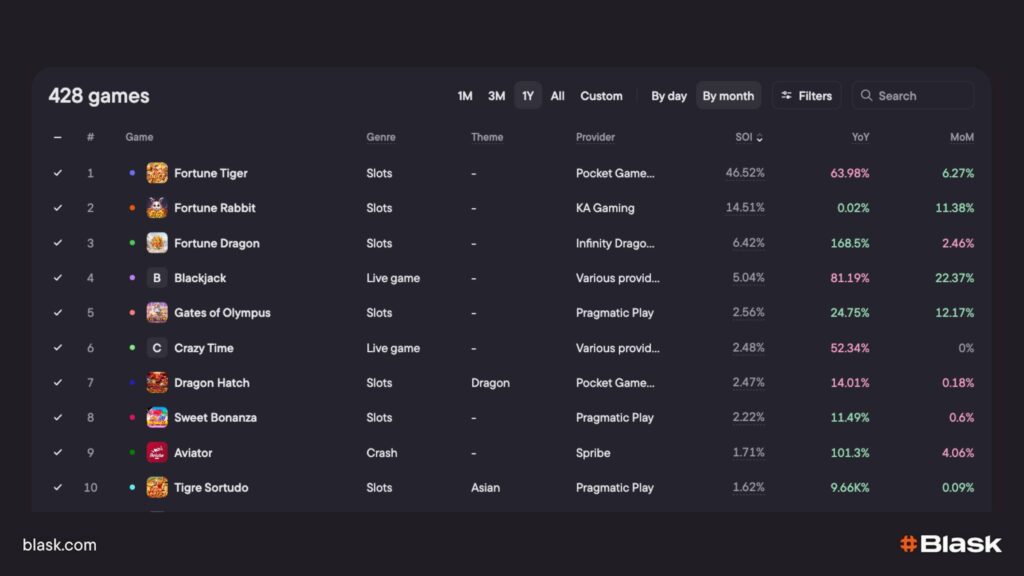- Updated:
- Published:
Slot game
Why slot games still drive the pulse of iGaming
Slot games remain the core revenue engine for online casinos, accounting for up to 70% of GGR in many markets. But the performance of a single game hinges on two highly dynamic factors:
- Player demand — how many users are actively seeking it today.
- Lobby placement — where exactly the game appears on site.
Blask Games combines these two signals — Game Visibility Rank (GVR) and Blask Index / Share of Interest (SoI) — to give B2B teams a reliable, real-time view of what’s working, what’s not, and what to do next.
What is a slot game in 2025?
A modern slot game isn’t just a digital one-armed bandit. It’s a sophisticated entertainment product defined by dozens of parameters — RTP, volatility, bonus mechanics, genre, branding, licensing.
Slot types range from:
- Classic 3-reel slots
- Video slots with 5+ reels and advanced features
- Megaways™ and multiline formats with thousands of win paths
- Crash and instant-win games
- Progressive jackpots and branded IP titles
Blask’s Customer Profile analytics allow you to break this down by genre, player segment, or geography to understand how preferences shift between countries or user cohorts.
Why slot games are a business lever — not just entertainment
- For operators, slots are long-tail ARPU drivers. Keeping a game in a top-10 lobby position (GVR < 10) can dramatically improve brand visibility and revenue, often reflected in BAP (Brand’s Accumulated Power).
- Affiliates use trending slot data to build timely landing pages with real SEO traction, replacing generic game reviews with insights backed by Blask Index.
- Game providers use Blask to monitor their releases in real time: which operator gave them top placement? Where are they buried? Which country is underperforming?
- Marketers and SMM teams track spikes in player interest (SoI) by theme or season. A sudden rise in demand for dragon-themed slots in Brazil? A perfect trigger for a fast-reacting campaign — before competitors catch on.
How Blask Games connects lobby position with market demand
The screenshot above shows Blask Games in action. It compiles real-time operator lobby data across 50+ markets and overlays that with daily behavioral trends.
Each slot gets:
- Game Visibility Rank (GVR) — where it appears in the operator lobby
- Blask Index — daily demand measurement
- Share of Interest (SoI) — market share of attention
- Historical trendlines for GVR and Index
- Breakdowns by country and operator
This enables teams to act early. If a slot is spiking in SoI in India but hasn’t broken into the top 20 GVR—there’s an opportunity. If a high-value game is sliding in GVR while interest holds steady, it’s time for a marketing push or placement renegotiation.

How core Blask metrics quantify slot performance
Blask Games is integrated with the core business metrics of the Blask platform:
- BAP reflects how a top-performing slot boosts brand-wide attention
- APS shows how well a game converts new players in real time
- CEB helps benchmark earnings potential against market averages
A slot is more than a game. It’s a performance signal across your brand, user funnel, and revenue projections.
What slot trends to watch in 2025
Recent months have shown clear patterns across markets:
- Crash games are claiming lobby space fast in LATAM
- Branded IP slots (anime, historical legends) are surging in Asia
- In India, sports and culturally themed slots spike ahead of events like IPL
- Seasonal titles (Halloween, Christmas) now peak and drop faster than ever
Blask helps you spot these patterns through filters and alerts — weeks before traditional reports catch up.
Final takeaway: a slot is not just a game — it’s a signal
Slots are how the market speaks to you. Blask is how you listen.
Real analytics means knowing not just what happened last month, but what’s happening right now — and where it’s heading next.
If you want to see which games your players will click tomorrow — today — book a Blask demo and experience slot analytics that actually move your KPIs.